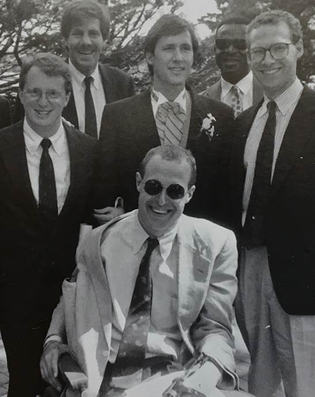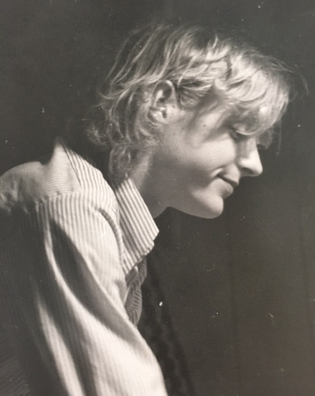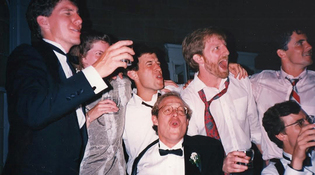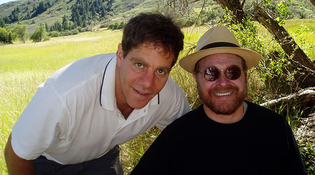 loading
loading
featuresBoundlessAfter a devastating accident, Ed Bennett ’84 showed “how to piece a life together.” Andy Court ’83 is a producer for the CBS News program 60 Minutes.  Ed Bennett ’84 (seated) became a quadriplegic after an accident just before his sophomore year. He’s shown here at the 1990 wedding of Hampton Sides ’84, with (from left to right) Paul Hofheinz ’84, Andy Court ’83, Hampton Sides, Kofi Blankson-Ocansey ’84, ’91MPPM, and Morris Panner ’84. View full imageI’ll never forget the first time I met Edward B. Bennett III. It was in the dining hall of Morse College, in 1981. I was a sophomore disillusioned with the Yale Daily News. A friend had told me there was someone who wanted to revive a magazine called the New Journal. He wanted to be the publisher and was looking for an editor in chief. “You should meet him,” she said, and arranged for us to have dinner. Ed rolled up in a motorized wheelchair he controlled with one hand. He was brimming with a confidence bordering on bravado. “So, why do you want to work for the New Journal?” he asked. The way he said it, you’d think this was an interview for a real job. The Yale Daily News didn’t pay its reporters, but at least it had a building, an endowment, and a constant supply of students willing to work for it. It existed. The New Journal didn’t. Ed had no money, no staff, no office. There was nothing but the glint in his eye. “I don’t want to work for the New Journal,” I said, somewhat irritated. “Why would I want to work for it?” Ed (or “Edder,” to family and some friends) proceeded to tell me the history of the magazine—how it had once been the best nonfiction magazine at Yale, and it would be so again, he was going to make sure of it. And if I decided not to work with him on it, his only hope was that a year from now I would pick up a copy of the magazine and feel tremendous regret knowing that I could have been the editor of this stellar publication. At the time, I did not understand the full extent of Ed’s disability. But it was quite clear he could not walk and had only the partial use of one hand. At dinner that evening, he could not cut his own food; someone had to do it for him. And yet I had no doubt that he was going to succeed in reviving this magazine, for the simple reason that he wasn’t going to let anything stop him. He was hungry for redemption, and the magazine figured prominently in his plan.  Ed as a boy. View full image Ed and Andy in the Morse College courtyard. View full imageOnly later would I come to understand why. Ed had been walking around campus just like me during his freshman year at Yale. He had gotten involved in the New Journal and rose to become its publisher. In September 1979, just before the start of his sophomore year, he and a friend went to spend a relaxing weekend on the Connecticut coast. Ed dove into shallow water and broke his neck. He was suddenly a quadriplegic. At Craig Hospital, a spinal rehabilitation facility in Englewood, Colorado, he lay in bed wondering if life was still worth living. “Can I piece a life together?” he asked the hospital’s director of psychology, Lester Butt. “Can you still love?” Butt replied. While Ed was in the hospital, the New Journal ran out of money and stopped publishing. The magazine had been founded in 1967 by several students—Daniel Yergin ’68, Steven Weisman ’68, Howard Newman ’69, ’69MA, Jeff Pollock ’69, Jonathan Lear ’70, and others—with help from history professor Nicholas Rizopoulos ’58, ’64PhD. It was named after the style of literary journalism popularized by Tom Wolfe ’57PhD, the “New Journalism,” and over the years it had produced some brilliant articles and served as an important training ground for writers and entrepreneurs. (Yergin would go on to win the Pulitzer Prize for his seminal book about oil and power, The Prize. Weisman would have an illustrious career as a correspondent for the New York Times. Newman became a successful venture capitalist and Lear a professor of philosophy at the University of Chicago.) Ed returned to Yale in January 1981. It was nine years before the passage of the Americans with Disabilities Act, and Yale and New Haven were by no means as accessible as they are today. There were curb cuts in some places, but not others. There were stairs everywhere, but not always ramps or elevators. Sometimes, four or five of us would have to lift Ed’s heavy battery-operated wheelchair up steep stairs to get him into a building. (If that building happened to be a local bar or restaurant, the real challenge was carrying him back down after we’d had a few drinks.)  Howling (after a few cocktails) at the wedding of Bruce Jacobsen ’82 in 1989. Bruce, at left, and Ed are with five Class of ’82 members. Left to right: Louise Burnham Packard, Hunter Reisner, Nate Dudley, Willie MacMullen, and Peter Collery (seated). View full imageEd had to run a small business just to get through the day. He paid personal assistants to help him get up in the morning and go to bed at night. He had to teach them how to safely lift him in and out of his chair, how to help him go to the bathroom, and how to deal with medical problems that regularly arose. He had to make sure someone was always scheduled to come, and he needed back-ups in case an aide couldn’t make it at the last minute. Friends and suitemates would volunteer to help in a pinch, but he didn’t like to impose on his friends. Ed had difficulty writing with a pen. He couldn’t scribble notes furiously during class like everyone else. He had to dictate his papers and correspondence. He read books using a special stand that held the book in place. Things the rest of us didn’t have to worry about at all were life-and-death matters for him. A clogged urinary catheter could quickly lead to a condition that caused his blood pressure to spike and put him at high risk of having a stroke. A small red spot on his skin could quickly turn into a dangerous pressure ulcer. Often, the only remedy was to lie in bed for a day or two, airing the wound, and missing class. The complexities of his condition were so substantial that no quadriplegic had ever graduated from Yale College. Passing his classes and getting his diploma would have been a sufficiently challenging goal. But I think Ed figured that if he could not walk again, he could at least get the New Journal back on its feet. After much deliberation, I decided to throw my lot in with his—to start, pretty much from scratch, rebuilding the magazine. It seemed like a heroic effort, and I remember writing, at the top of the very first list of stories we were working on, “THE SAGA BEGINS . . .” It was just the two of us back then. But then remarkable people joined us: Hampton Sides ’84, Morris Panner ’84, Paul Hofheinz ’84, Hilary Callahan ’85, Jim Lowe ’85, to name just a few. The magazine caught on. It became once again the best nonfiction magazine at Yale. Within a year, I started writing, “THE SAGA CONTINUES . . .” at the top of the story list. And later, as we were handing the magazine off to a new generation of editors, “THE SAGA NEVER ENDS . . .” The amazing thing is, the magazine’s still going strong—as an independent, student-run publication supported mainly by ad revenue. The format and overall look of it today are not that different from how it appeared when Ed revived it. Two of the magazine’s board members, attorney Peter Cooper ’60, ’64LLB, ’65Mus, and bookkeeper Linda Coleman, have been helping the student editors ever since Ed asked them to volunteer 36 years ago. In 1984, Ed became the first quadriplegic to graduate from Yale College, according to Henry Chauncey Jr. ’57, the former secretary of Yale University. Chauncey had been a friend of Ed’s father, Edward B. Bennett Jr. ’56, ’63JD. He had visited Ed after his injury and stayed in touch throughout his rehabilitation. Ed would later credit Chauncey and other friends with helping to save his life after the accident. Ed went on to attend Yale Law School and Yale Divinity School, but he didn’t complete his degrees. He found studying the law intellectually stimulating but couldn’t see himself practicing. Nor did he think he had the right temperament for pastoral work. He believed his calling was management, and so he decided to go into the family business—banking. He rose to become the president of the First National Bank of Santa Fe.  Andy and Ed at a state park in Colorado, about 12 years ago. View full imageOur friendship grew over the years. I visited him in New Haven during grad school and in Santa Fe when he was working at the bank. He was the best man at my wedding and the godfather of my first child. For his 40th birthday, he invited me and other friends to celebrate with him in New Orleans. Here’s how Hampton Sides, the author of Ghost Soldiers and other best-selling books, remembered Ed’s birthday celebration:
Ed never married, but he maintained a wide network of friendships. There were old college friends like Jeff Foster ’82 and Risher Randall Jr. ’82, but also kindred spirits in Santa Fe, like the architect Suby Bowden. Jim Rush ’77PhD, the dean of Morse College when Ed was a freshman, stayed in touch with Ed throughout his life. So did Peter Schuck, one of his professors at Yale Law School. Lester Butt, the psychologist at Craig Hospital who asked Ed whether he could still love, attended Ed’s graduation at Yale and came to think of him as a soul mate and brother. Ed was proud of his achievements, and saddened that disability is often portrayed in the media in terms of dependency and economic burden. In 1993, the New York Times Magazine ran an article about a hospital’s costly effort to save the life of a man who had been so severely paralyzed that he had to be put on a ventilator. “Is it worth saving a life if it is to be spent trapped in a motionless prison?” the reporter asked. In response, Ed wrote a letter to the editor: “No one should dismiss the enormous energy disability requires,” he said, “but we must realize that people with disabilities are not just takers. We make contributions to our families and communities.” His contribution was particularly evident on April 8, when the New Journal celebrated its 50th anniversary at the Yale Club in New York. Daniel Yergin was there. And Steven Weisman and Howard Newman. James Bennet ’88, the editorial page editor of the New York Times, said that if it hadn’t been for the New Journal he might not have gone into journalism. As I looked at that room full of talented and accomplished people, I couldn’t help thinking that we probably wouldn’t be here at all if Ed had not come charging back to school after his accident, determined to revive the magazine. It didn’t seem fair that Ed never got to see that 50th anniversary celebration. He had been bedridden, in faltering health, for many years. He died on March 3, of cardiac arrest, at age 57. At the anniversary celebration, we launched the Ed Bennett Memorial Fund for the New Journal, which will be used to support original long-form reporting on Yale and New Haven.  The last photo taken of Ed with his sister, Molly Bennett. He had been bedridden and in failing health for many years. View full imageWhen Ed died, I asked friends to send me pictures and remembrances. As the e-mails poured in, I started to realize how many classmates had made him the best man at their wedding or the godfather of their child. People came from all over the country to attend Ed’s funeral in Santa Fe in March. “If you think about who was at the ceremony,” psychologist Lester Butt said, “maybe a third were Yale folks. It was stunning to me. I was amazed in such a good way. What a brotherhood it was.” Later, some of us went to Hampton and Anne Sides’s home in the hills of Santa Fe, with the lights of the town glimmering below. We drank bourbon and talked about Ed. And it was only then that it occurred to me: his greatest gift to us was one another. That weekend, one of Ed’s old friends, Neil Solomon ’83, ’90MD, showed me an essay Ed had written for the Yale Divinity School in 1995. In it, Ed wrote:
When I think about all the time we spent at the magazine, hunting for the next great scoop, I am surprised it never occurred to us that the best story we were working on was our own. This remarkable yarn of a determined young man who brought so many people together, who experienced the sufferings of Job yet still somehow retained his faith, was our best story yet. On Ed’s gravestone, his sister Molly put a quote from Archimedes that Ed had always loved: “Give me a lever and place to stand, and I will move the earth.” The idea was, like Ed’s personality itself, big and bold and full of promise, infectious in its vision of what we can do if we are determined enough to do it. I am glad I met him that day in the dining hall of Morse College. The world will not be quite the same without him.
|
|
6 comments
-

Marc Warman, 7:53am May 10 2017 |  Flag as inappropriate
Flag as inappropriate
-

David Sullivan, 11:15pm May 11 2017 |  Flag as inappropriate
Flag as inappropriate
-

PAMELA S DAVIS, 1:28pm May 22 2017 |  Flag as inappropriate
Flag as inappropriate
-

Evelyn Korn, 11:58am May 25 2017 |  Flag as inappropriate
Flag as inappropriate
-

Mieke Holkeboer, 9:44am June 12 2017 |  Flag as inappropriate
Flag as inappropriate
-

Greg Ellena, 11:58pm June 18 2017 |  Flag as inappropriate
Flag as inappropriate
The comment period has expired.A great article and tribute to Ed Bennett. A must read for high school and college students, people with careers in rehabilitation medicine and individuals with disabilities Marc Warman Yale Med School 1990
Thanks to Andy Court for this great piece, and kudos to the magazine for putting Ed on the cover, though flipping through today's mail was a sad way to learn of his death.
A lovely tribute to a great man and friend. Edder brought light wherever he went and made my law school years some of my best. I will miss Ed very much but will always treasure the memories I shared with him.
Thanks Andy for that wonderful article. It brought tears to my eyes. I remember meeting him at one the girls' bat mitzvahs and thinking about how upbeat he was.Sad but wonderful memories for you all.
Andy, I too am sick to hear about Ed's passing. He was such an elegant guy--down to earth, for sure, never a snob, but elegant, handsome, with a preppy edge. Ed was dedicated to his friends, brilliant, funny, a master of patience. And a refined and empathic listener. Ed struggled mightily and nobly on a daily basis, but he never let that define his relationships or his interaction with humanity. Thanks Andy for the beautiful piece about a beautiful human being. This world of ours is surely less without him.
Here's the perspective of a great friend of Edder's, albeit a Harvard guy (Harvard College '77):
I worked with Edder from 1988 - 2005. He was not just a great man, but rather, he was learned, inspirational, honest, properly critical, loving, caring and respected. He took the time to count every book in his voluminous library with my then nine year old daughter, to who he most eloquently introduced C. S. Lewis.
More importantly, he sought and knew Our Lord, for which we are all comforted with his salvation and triumph. This is a man from whom Yale and all others can derive example, direction and hope.
Greg Ellena